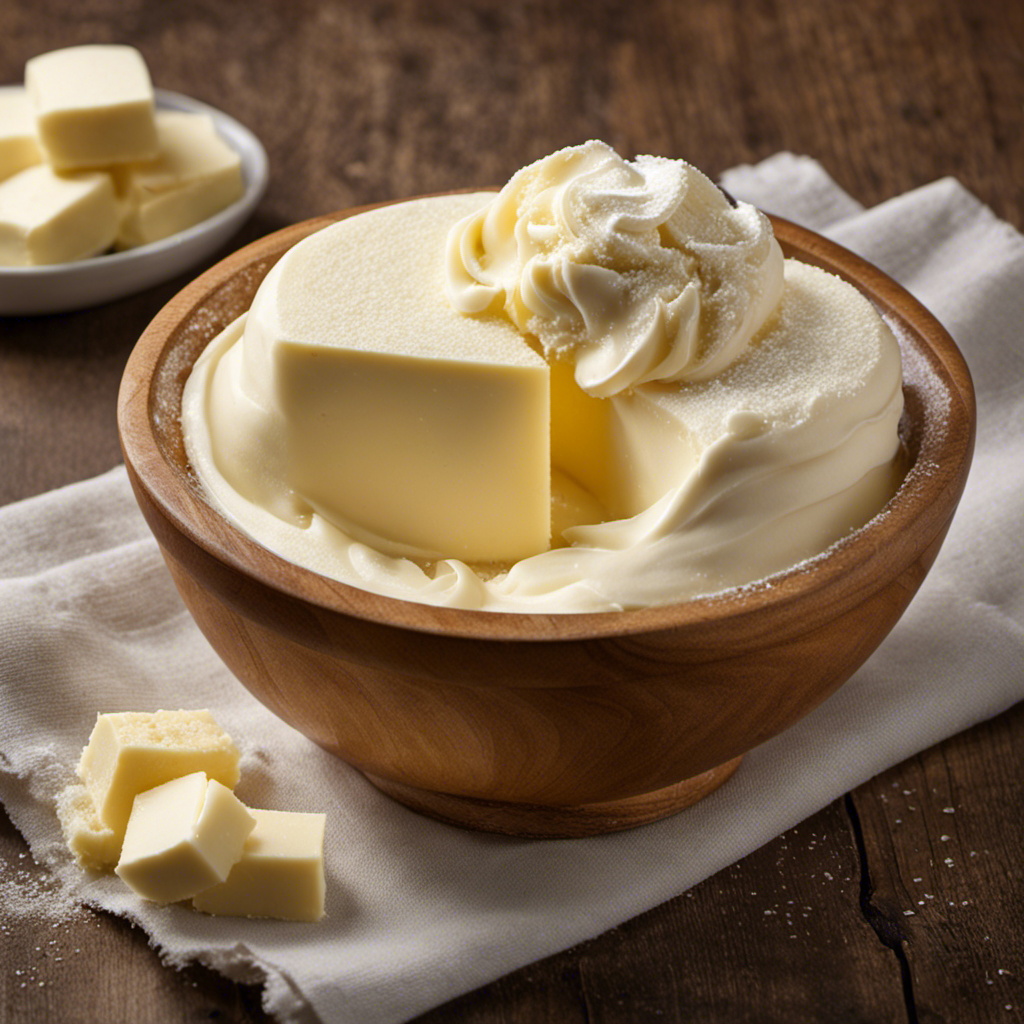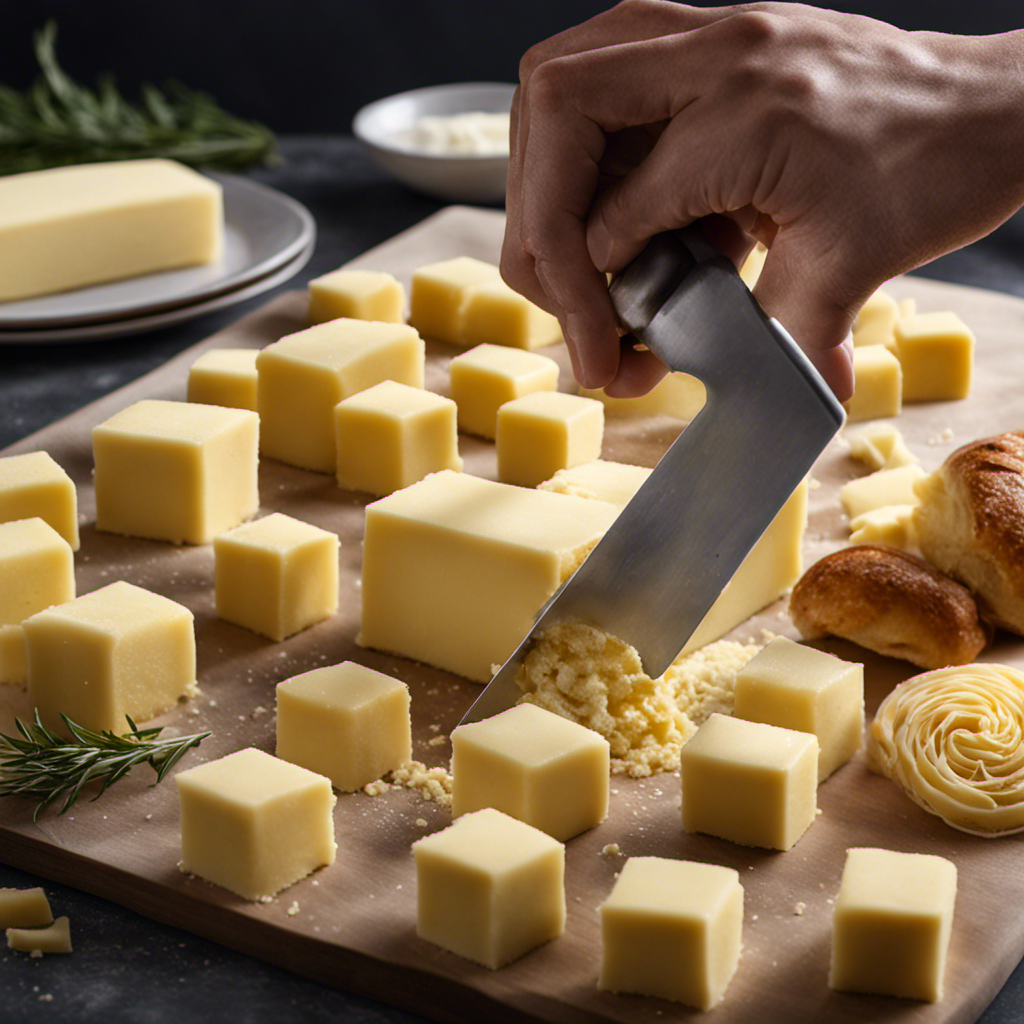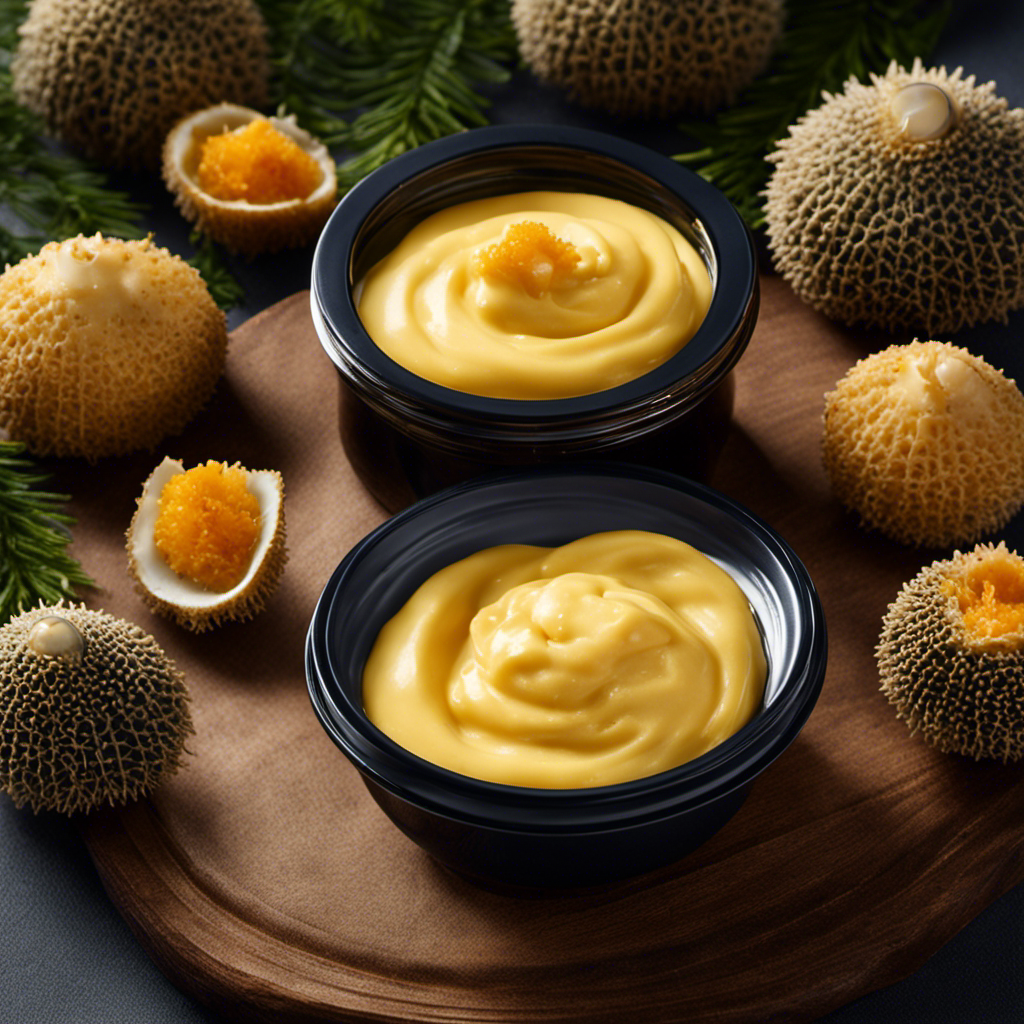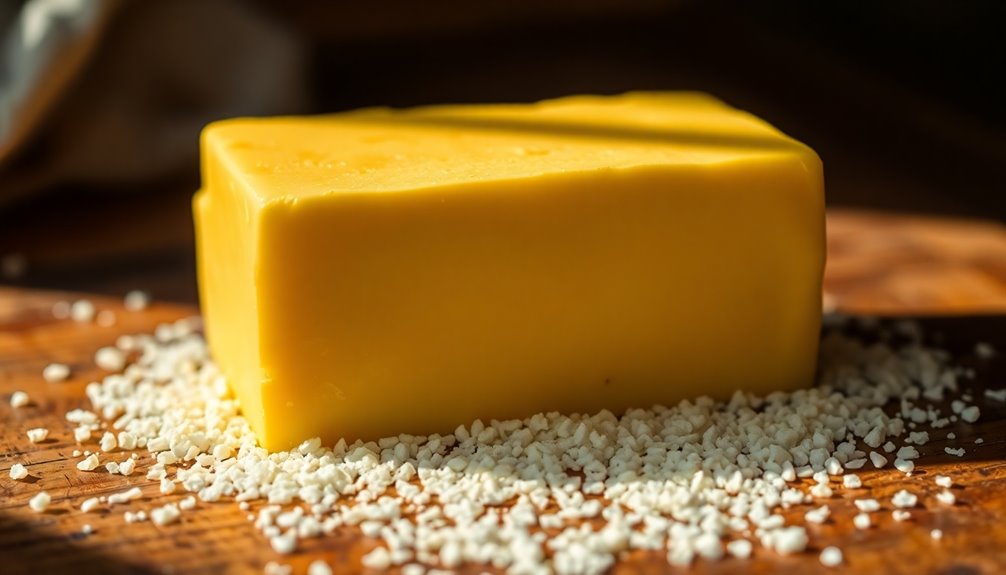Have you ever experienced the frustration of trying to cream butter and sugar together, only to end up with a grainy texture? It’s like trying to mix oil with water – they just won’t combine.
But fear not! I’ve got the solution to your baking woes. In this article, I’ll guide you through the science behind grainy creamed butter and sugar and share some expert tips on how to fix it.
With the right techniques and a little know-how, you’ll be whipping up perfectly creamy batters in no time.
Let’s get started!
Key Takeaways
- Graininess occurs when sugar is not fully dissolved in butter
- Different sugar types have varying degrees of fineness
- Proper mixing techniques include adjusting mixing speed gradually, beating butter and sugar for 3 to 5 minutes, pausing to scrape down the sides of the bowl, and avoiding over-mixing
- Adjusting the temperature of the ingredients, particularly the butter, is crucial for a smooth creamed butter and sugar mixture
Understanding the Science Behind Grainy Creamed Butter and Sugar
Understanding the science behind grainy creamed butter and sugar can help you troubleshoot and fix this common baking issue.
When creaming butter and sugar, the goal is to create a smooth and fluffy mixture. Graininess occurs when the sugar is not fully dissolved in the butter, resulting in a gritty texture. This can happen due to various factors, such as using the wrong mixing technique or using certain types of sugar.
Different sugar types have varying degrees of fineness, which affects how well they dissolve in butter. For example, granulated sugar is coarser and takes longer to dissolve compared to powdered sugar.
Proper Mixing Techniques for Creaming Butter and Sugar
To properly mix your ingredients, make sure you’re using softened butter and beat it together with the sugar until light and fluffy. This step is crucial for achieving a smooth and creamy texture in your mixture.
Here are some techniques to consider when mixing your ingredients:
-
Adjusting mixing speed: Start by mixing on low speed to prevent splattering, then gradually increase the speed to medium-high for optimal air incorporation.
-
Incorporating air into the mixture: Beat the butter and sugar together for a longer duration, around 3 to 5 minutes, to incorporate air bubbles. This will contribute to a lighter texture in your final product.
-
Scraping down the sides: Pause occasionally to scrape down the sides of the bowl. This ensures that all the ingredients are evenly mixed and prevents any pockets of unmixed butter or sugar.
-
Avoid over-mixing: Once the mixture is light and fluffy, stop mixing. Over-mixing can cause the butter to melt and lead to a greasy texture.
-
Use a stand mixer or hand mixer: These tools provide the necessary power and speed control to achieve the desired texture.
By adjusting the mixing speed and incorporating air into the mixture, you’ll be on your way to a perfectly creamed butter and sugar.
Now, let’s move on to the next step of adjusting the temperature of the ingredients for a smooth cream…
Adjusting the Temperature of the Ingredients for a Smooth Cream
Now, let’s focus on getting the best texture by adjusting the temperature of your ingredients. Achieving a smooth consistency in creamed butter and sugar can be tricky, but with the right temperature adjustments, it can be easily achieved.
Temperature plays a crucial role in the creaming process. If the butter is too cold, it won’t incorporate air properly, resulting in a dense and grainy texture. On the other hand, if the butter is too warm, it will become greasy and will not hold its shape.
Here’s a handy table to help you understand the ideal temperature range for each ingredient:
| Ingredient | Ideal Temperature Range |
|---|---|
| Butter | 65°F – 68°F (18°C – 20°C) |
| Sugar | Room Temperature |
The Importance of Softened Butter in Creaming
When it comes to creaming butter for baking, the temperature of the butter plays a crucial role. The ideal temperature for creaming butter is softened but still cool to the touch.
This allows for proper incorporation of air and sugar, resulting in a light and fluffy texture.
Butter Temperature for Creaming
Make sure your butter is at room temperature before creaming it with the sugar to avoid a grainy texture. This is because room temperature butter is softer and more pliable, allowing it to incorporate air more easily during the creaming process. When the butter is too cold, it doesn’t blend well with the sugar, resulting in a grainy mixture.
To ensure your butter is at the right temperature, leave it out of the fridge for about 30 minutes before starting the creaming process. Here are some tips to achieve the perfect butter temperature for creaming:
- Take the butter out of the fridge ahead of time
- Cut the butter into small cubes to help it soften quicker
- Test the temperature by pressing your finger gently on the butter – it should leave a slight indentation
- If the butter is still too cold, microwave it in short bursts of 5 seconds until it reaches room temperature
- Avoid using melted butter as it can lead to a greasy texture.
Texture of Creamed Butter
When it comes to achieving the perfect texture for creamed butter, the temperature of the butter plays a crucial role. The ideal butter temperature for creaming is around 65°F (18°C). This allows the butter to be soft enough to easily incorporate air, but not so soft that it becomes greasy and loses its structure.
To achieve the right butter temperature, I recommend taking the butter out of the refrigerator and letting it sit at room temperature for about 30 minutes. This will soften the butter just enough to make it easier to cream with the sugar.
In terms of creaming techniques, it is important to beat the butter and sugar together until the mixture is light and fluffy. This can be done using an electric mixer or by hand with a sturdy wooden spoon. The key is to incorporate as much air as possible into the mixture, which will result in a smooth and creamy texture.
Role of Softened Butter
Softened butter is crucial in achieving a smooth and creamy texture for your baked goods. When butter is too cold, it can result in a grainy and lumpy mixture, which is not ideal for recipes that require creaming butter and sugar. Softened butter benefits the texture of your baked treats by allowing it to incorporate air and create a lighter, fluffier result.
Here are a few key benefits of using softened butter:
- Easier to mix: Softened butter blends more easily with other ingredients, ensuring a uniform distribution throughout the batter.
- Better leavening: Softened butter helps create a better rise in your baked goods, resulting in a light and tender texture.
- Improved flavor: Softened butter allows the flavors to meld together, giving your baked goods a rich and balanced taste.
- Enhanced moisture retention: Softened butter traps moisture, keeping your treats moist and preventing them from drying out.
- Smooth and creamy consistency: Softened butter makes it easier to achieve a smooth and creamy batter, resulting in a more enjoyable eating experience.
Using the Correct Type of Sugar for a Creamy Texture
Using the right type of sugar will ensure a creamy texture for your creamed butter and sugar mixture. When it comes to sugar substitutes or alternative sweeteners, it’s important to choose the one that will provide the desired consistency. Here is a table comparing different types of sugar and their effects on creamed butter:
| Sugar Type | Texture | Creaming Result |
|---|---|---|
| Granulated sugar | Fine crystals | Smooth and creamy |
| Powdered sugar | Finely ground | Light and fluffy |
| Brown sugar | Moist and coarse | Dense and chewy |
| Coconut sugar | Coarse and grainy | Gritty texture |
For a creamy texture, granulated sugar is the best choice. Its fine crystals dissolve easily, creating a smooth and creamy mixture. Powdered sugar can also be used for a lighter and fluffier result. However, avoid using brown sugar or coconut sugar, as they can make the mixture dense, chewy, and gritty. By selecting the right sugar, you can ensure a perfect creamed butter and sugar mixture every time.
Troubleshooting Common Mistakes in Creaming Butter and Sugar
To troubleshoot common mistakes in creaming, pay attention to the temperature of your ingredients. Proper creaming technique is crucial for achieving a smooth and creamy texture in your butter and sugar mixture. Here are some tips to troubleshoot a grainy texture:
- Make sure your butter is at room temperature before creaming.
- Use granulated sugar instead of powdered sugar for a better creaming process.
- Cream the butter and sugar together for the recommended amount of time, usually around 2-3 minutes, until light and fluffy.
- Avoid over-creaming, as this can lead to a grainy texture.
- If your mixture still appears grainy, try beating it for a little longer to allow the sugar to dissolve completely.
By following these steps, you can achieve a flawless cream for your baked goods.
Now, let’s move on to the next step of incorporating room temperature eggs.
Incorporating Room Temperature Eggs for a Flawless Cream
Now that your butter and sugar mixture is smooth and creamy, it’s time to incorporate room temperature eggs for the next step.
Room temperature eggs are essential for achieving a flawless cream in your baking. When eggs are too cold, they can cause the butter to harden, resulting in a grainy texture.
To incorporate room temperature eggs, start by cracking them into a separate bowl and lightly whisking them. Then, gradually add the eggs to the butter and sugar mixture, beating well after each addition. This will ensure that the eggs are evenly distributed and fully incorporated.
The incorporating technique is crucial here to create a smooth and cohesive batter. Remember, room temperature eggs are key to achieving the perfect texture in your baked goods.
How to Rescue Over-creamed Butter and Sugar
When it comes to achieving a smooth and creamy texture in baked goods, there are a few key points to consider.
First, understanding the causes of a grainy texture can help troubleshoot the issue.
Second, learning techniques for achieving a smooth consistency can make all the difference.
Lastly, being aware of common mistakes to avoid can help prevent graininess in the first place.
Causes of Grainy Texture
One possible cause of a grainy texture in creamed butter and sugar is not allowing the butter to soften enough before mixing. When the butter is too cold, it cannot fully incorporate with the sugar, resulting in a grainy texture.
To troubleshoot common mistakes in creaming butter and sugar, it’s important to understand the science behind this issue. Here are some key points to consider:
- Soften the butter at room temperature for about 30 minutes before starting.
- Cut the butter into small pieces to speed up the softening process.
- Avoid using a microwave to soften the butter, as it can melt unevenly.
- Cream the butter and sugar together until light and fluffy, ensuring proper incorporation.
- If the mixture still turns out grainy, try using powdered sugar instead of granulated sugar for a finer texture.
Techniques for Smooth Consistency
To achieve a smooth consistency in your mixture, make sure to thoroughly incorporate the softened butter and sugar. Proper mixing techniques are crucial for avoiding a grainy texture in creamed butter and sugar.
Start by ensuring that your butter is at the right temperature – it should be soft but not melted. Room temperature is ideal.
Next, cream the butter and sugar together using an electric mixer or stand mixer. Mix on medium speed until the mixture becomes light and fluffy, about 2-3 minutes. Scrape down the sides of the bowl occasionally to ensure even mixing.
If you notice a grainy texture, try adjusting the temperature of the butter. If it is too cold, let it sit at room temperature for a few minutes before mixing again. If it is too warm, refrigerate it briefly before continuing.
Common Mistakes to Avoid
Make sure you are using the proper temperature for your butter to avoid any mistakes in achieving a smooth consistency in your mixture.
One of the common misconceptions when creaming butter and sugar is that room temperature butter means soft or melty butter. However, room temperature butter should still be slightly firm to the touch.
Another mistake to avoid is over-creaming the butter and sugar, which can lead to a grainy texture.
It is also important to use granulated sugar instead of powdered sugar, as the latter contains cornstarch that can contribute to graininess.
Additionally, using the paddle attachment on your mixer instead of the whisk attachment can help achieve a smoother consistency.
Tips for Preventing Grainy Creamed Butter and Sugar in the Future
If you want to prevent grainy creamed butter and sugar in the future, you should make sure to use softened butter and gradually add the sugar while mixing. Softened butter helps create a smooth and creamy texture, while adding the sugar gradually allows for proper incorporation and prevents graininess.
Another key tip is to ensure that both the butter and sugar are at room temperature before beginning the creaming process. Cold ingredients can result in an uneven mixture and a grainy texture.
Additionally, be mindful of over-creaming the butter and sugar mixture, as this can also lead to a grainy consistency. It is important to stop mixing once the butter and sugar are fully combined and have a light and fluffy texture.
Frequently Asked Questions
Can I Use Margarine Instead of Butter When Creaming With Sugar?
Using margarine in place of butter for creaming with sugar yields similar results. The margarine should be softened to room temperature, just like with butter. It may alter the flavor slightly, but the texture should remain the same.
Is It Necessary to Sift the Sugar Before Creaming It With Butter?
Creaming sugar and butter by hand can be effective, but using a mixer ensures a smoother texture. The temperature of the butter is crucial; it should be softened but not melted for optimal creaming.
Can I Use a Hand Mixer Instead of a Stand Mixer for Creaming Butter and Sugar?
Yes, a hand mixer can be used instead of a stand mixer for creaming butter and sugar. To achieve the perfect consistency, make sure the butter is softened and mix until light and fluffy.
How Long Should I Cream the Butter and Sugar Together for the Best Results?
To achieve a smooth and creamy texture in creamed butter and sugar, it’s important to cream them together for the right amount of time. Proper creaming technique is crucial for best results.
Can I Use Brown Sugar Instead of White Sugar for Creaming With Butter?
Yes, brown sugar can be used as an alternative to white sugar for creaming with butter. It adds a rich flavor and moist texture to baked goods. However, it may result in a slightly denser final product.
Conclusion
In conclusion, achieving a smooth and creamy texture in your butter and sugar mixture is crucial for creating the perfect baked goods.
By understanding the science behind grainy creamed butter and sugar, using proper mixing techniques, adjusting ingredient temperatures, and choosing the right type of sugar, you can avoid this common baking pitfall.
Incorporating room temperature eggs and knowing how to rescue over-creamed butter and sugar are also essential skills.
With these tips in mind, you’ll be able to create flawlessly creamy mixtures and prevent grainy results in the future.
Happy baking!










